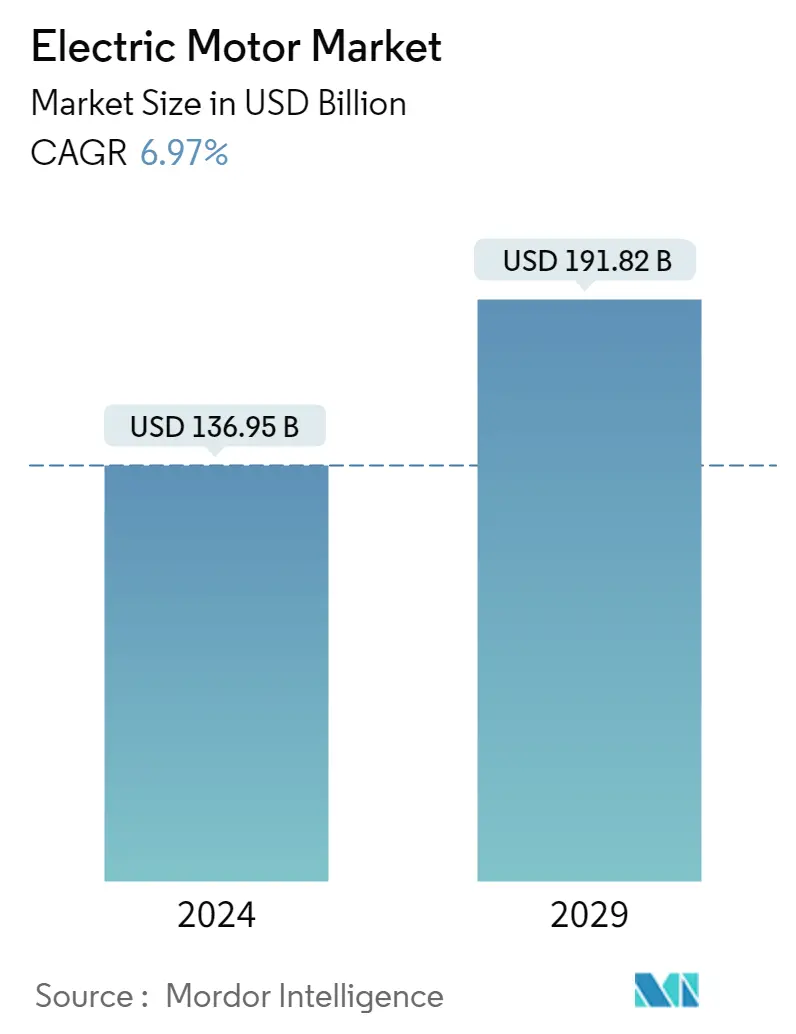Market Size of Electric Motor Industry

| Study Period | 2019 - 2029 |
| Market Size (2024) | USD 136.95 Billion |
| Market Size (2029) | USD 191.82 Billion |
| CAGR (2024 - 2029) | 6.97 % |
| Fastest Growing Market | Asia Pacific |
| Largest Market | Asia Pacific |
Major Players
*Disclaimer: Major Players sorted in no particular order |
Electric Motors Market Analysis
The Electric Motor Market size is estimated at USD 136.95 billion in 2024, and is expected to reach USD 191.82 billion by 2029, growing at a CAGR of 6.97% during the forecast period (2024-2029).
- Over the medium term, factors such as increasing residential usage of the electric motor, increasing adoption of electric vehicles, and increasing automation in various industrial processes, are expected to drive the electric motor market.
- On the other hand, the restraints like the life expectancy of these assets due to harsh operating conditions and fluctuating prices of raw materials are expected to hamper the market growth.
- Nevertheless, the technological developments for the advancement of electric motor technology create tremendous opportunities for the market. For example, emerging technologies like axial flux, in-wheel, etc., are gaining popularity. Axial flux motor technology offers numerous benefits like increased power and torque density and a pancake form factor ideal for integration in various scenarios.
- The Asia-Pacific region is expected to ace the market during the forecast period due to the progress in the industrial sector currently witnessed.
Electric Motors Industry Segmentation
The electric motors are operated through interaction between the magnetic field of the motor and the winding currents, producing rotation. Electric motors can convert electrical energy to mechanical energy, so they have widespread applications in fans, pumps, compressors, elevators, and refrigerators. Electric motors are a major piece of equipment used across industrial, commercial, and residential sectors. The demand for electric motors in the industrial industry arises from developing new industrial projects and needs due to the refurbishment of old infrastructure.
The market is segmented based on motor type, voltage, application, and geography. By motor type, the market is segmented into DC and AC. The market is segmented by voltage into less than 1 kV, between 1-6 kV, and higher than 6 kV. The market is segmented by application into residential, commercial, industrial, and automotive. The report also covers the market size and forecasts for the electric motor market across major regions. The market sizing and forecasts have been done for each segment based on revenue (USD).
| Motor Type | |
| AC | |
| DC |
| Voltage | |
| Less than 1 kV | |
| Between 1kV-6kV | |
| Higher than 6 kV |
| Application | |
| Residential | |
| Commercial | |
| Automotive | |
| Industrial |
| Geography | |||||||
| |||||||
| |||||||
| |||||||
| |||||||
|
Electric Motor Market Size Summary
The electric motor market is poised for substantial growth over the forecast period, driven by increasing residential usage, the adoption of electric vehicles, and heightened automation across various industrial processes. Despite challenges such as the life expectancy of motors in harsh conditions and fluctuating raw material prices, technological advancements present significant opportunities. Innovations like axial flux and in-wheel motor technologies are gaining traction, offering benefits such as enhanced power and torque density. The Asia-Pacific region is expected to lead the market, bolstered by robust industrial sector growth, particularly in countries like China and India, which are key players in industries such as steel, chemicals, and petrochemicals.
The automotive segment is anticipated to experience notable expansion, fueled by the global shift towards electric vehicles as a sustainable transportation solution. This transition is supported by government incentives and policies promoting electromobility, alongside rising environmental awareness and fuel costs. The demand for electric motors is set to surge, particularly in regions like China, the United States, Japan, South Korea, and Europe, where electric vehicle sales are rapidly increasing. The market is characterized by fragmentation, with major companies like ABB Ltd., AMETEK Inc., Johnson Electric Holdings Limited, Siemens AG, and Toshiba Corp. playing significant roles. Recent collaborations and investments, such as those by Flash and Nidec Corporation, further underscore the dynamic developments within the industry.
Electric Motor Market Size - Table of Contents
-
1. MARKET OVERVIEW
-
1.1 Introduction
-
1.2 Market Size and Demand Forecast in USD, till 2028
-
1.3 Recent Trends and Developments
-
1.4 Government Policies and Regulations
-
1.5 Market Dynamics
-
1.5.1 Drivers
-
1.5.1.1 Increasing Residential Usage of the Electric Motor
-
1.5.1.2 Rising Adoption of Electric Vehicles
-
-
1.5.2 Restraints
-
1.5.2.1 Fluctuating Prices of Raw Materials
-
-
-
1.6 Supply Chain Analysis
-
1.7 Porter's Five Forces Analysis
-
1.7.1 Bargaining Power of Suppliers
-
1.7.2 Bargaining Power of Consumers
-
1.7.3 Threat of New Entrants
-
1.7.4 Threat of Substitutes Products and Services
-
1.7.5 Intensity of Competitive Rivalry
-
-
-
2. MARKET SEGMENTATION
-
2.1 Motor Type
-
2.1.1 AC
-
2.1.2 DC
-
-
2.2 Voltage
-
2.2.1 Less than 1 kV
-
2.2.2 Between 1kV-6kV
-
2.2.3 Higher than 6 kV
-
-
2.3 Application
-
2.3.1 Residential
-
2.3.2 Commercial
-
2.3.3 Automotive
-
2.3.4 Industrial
-
-
2.4 Geography
-
2.4.1 North America
-
2.4.1.1 United States
-
2.4.1.2 Canada
-
2.4.1.3 Rest of North America
-
-
2.4.2 Europe
-
2.4.2.1 Germany
-
2.4.2.2 France
-
2.4.2.3 United Kingdom
-
2.4.2.4 Rest of Europe
-
-
2.4.3 Asia-Pacific
-
2.4.3.1 China
-
2.4.3.2 India
-
2.4.3.3 Japan
-
2.4.3.4 South Korea
-
2.4.3.5 Rest of Asia-Pacific
-
-
2.4.4 South America
-
2.4.4.1 Brazil
-
2.4.4.2 Argentina
-
2.4.4.3 Rest of South America
-
-
2.4.5 Middle-East and Africa
-
2.4.5.1 Saudi Arabia
-
2.4.5.2 United Arab Emirates
-
2.4.5.3 South Africa
-
2.4.5.4 Rest of Middle-East and Africa
-
-
-
Electric Motor Market Size FAQs
How big is the Electric Motor Market?
The Electric Motor Market size is expected to reach USD 136.95 billion in 2024 and grow at a CAGR of 6.97% to reach USD 191.82 billion by 2029.
What is the current Electric Motor Market size?
In 2024, the Electric Motor Market size is expected to reach USD 136.95 billion.

